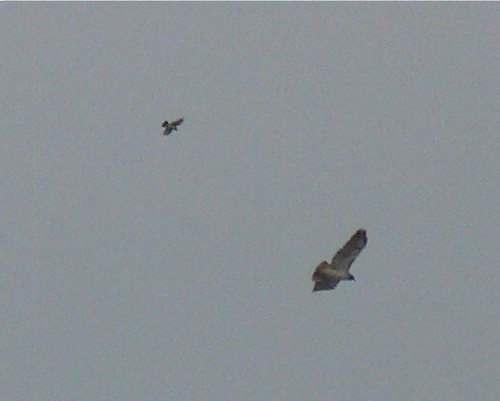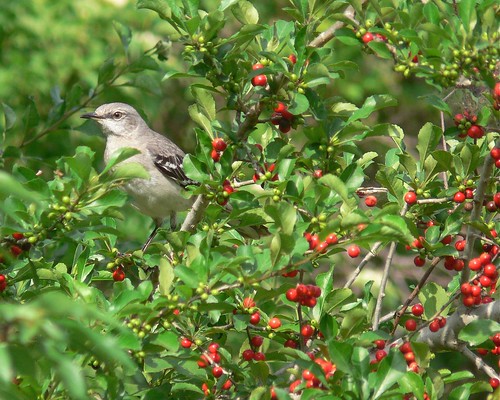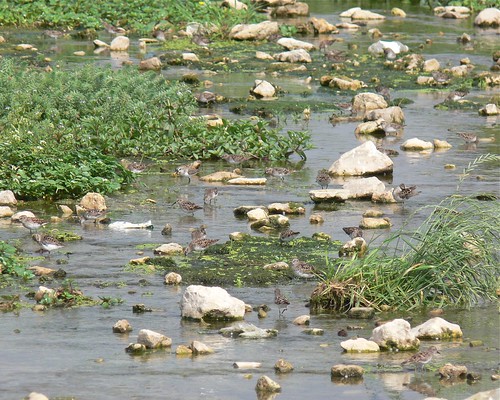It's late April, approaching the peak in species diversity of north-bound migrating birds through central Texas, but not many are being seen. Conventional wisdom in the birding community is that this is because of the steady south winds we've had for so many days. If a bird migrating north has a good tailwind it won't stop as often, so it won't be seen by birders as often. So when I spent 2 hours on Lake Creek Trail yesterday morning, I wasn't expecting to see very many migrants and I didn't. But I enjoyed some of our year-round and summer-resident birds. Right by the Parmer Village drainage pond I watched a Red-tailed Hawk get chased by 2 Loggerhead Shrikes. They were far away but I could identify the hawk by its red tail and the dark leading edges of its wings. I identified the shrikes by their vocalizing. Here's a photo I got of the hawk and one of the shrikes.
By the creek I found 2 Mulberry trees. I don't know my plants very well so I'd be curious if anyone knows if this is a Red Mulberry (Morus rubra) or White Mulberry (Morus alba)? These are great trees to find migratory birds that eat berries in, like orioles, buntings, grosbeaks, etc. One of them was full of Cedar Waxwings when I found it.
I couldn't resist taking this photo of a Northern Mockingbird among the bright red berries of a Possumhaw bush. I believe I was hearing at least 1 mockingbird singing every minute I was outside that morning!
In the creek bed in the middle of the playing fields I was happy to find the first Green Heron I've seen in the neighborhood this year. These birds forage in the creek but actually nest in the trees among our houses. While I was watching the heron I saw a bit of movement and realized I was right in front of over 50 Least Sandpipers without even realizing it! They were just quietly foraging and I hadn't seen them. These tiny birds are almost year-round residents on our creek. They winter here and breed up in Canada and Alaska. But their migration is so spread out and they have such a wide wintering range (from the southern United States all the way to the north half of South America), that there are almost always a few on their way north or south that can be found here. June is the only month that they usually can't be found. Here's a photo I got showing 33 of them. (If you click on it you can see where I marked them all with Flickr notes.)
For Easter morning I decided to sleep in, but I did get out of the house for a jog around mid-morning. And near Hazelhurst and Broadmeade I heard the cry of a Broad-winged Hawk. This is the same area that this summer-resident hawk has nested in years past. What a nice easter egg to find!





4 comments:
I'd have to get a closer look to be sure, but I think it is a Red Mulberry. Texas Mulberry (M. microphylla) is another possibility here. But Texas Mulberry is smaller (shrub or small tree) compared to White or Red Mulberry and has smaller leaves. BTW - The Red and Texas Mulberry are both native to this area; the White Mulberry (M. alba) is a non-native from China.
Thanks Bill! I was guessing White Mulberry based on the smooth glossy leaves.
The White Mulberry aka Russian Mulberry is non-native (as Bill mentioned) and the berries are not favored by birds. If birds were feeding on it my guess would be rubra.
Hi Mikael,
I wonder if you can help me identify a bird that I photographed today in the neighborhood.
it's at http://myphotomemries.blogspot.com
If you know what it is, just post a comment under the post.
Thanks in advance!
Mike Ziegler
Post a Comment